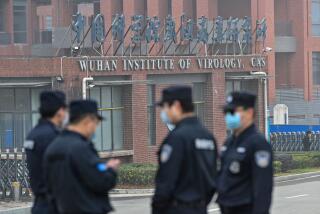AIDS Experts Discounting Threat of Mystery Virus : Health: Baffling cases are rare, don’t necessarily signal public health alarm, world conference is told.
AMSTERDAM — AIDS and public health experts Tuesday debated the possible emergence of a new and undetectable AIDS-like virus but stressed that the more than two dozen mystery cases that have suddenly become the focus of attention here do not necessarily signal a new public health threat.
Researchers at a hastily put-together session at the eighth International Conference on AIDS called upon clinicians around the world to report additional instances of baffling cases where those suffering from what appears to be acquired immune deficiency syndrome have failed to test positive for either of the two known viruses in the AIDS family.
They emphasized that the cases reported thus far were rare, having occurred over a period of several years, unlike AIDS, which started similarly with a handful of cases but escalated rapidly.
And they said there was no apparent “clustering” of cases by geography or through partners--as there was initially with AIDS among gay men--that would indicate evidence of a new agent that was transmissible.
“We’re talking about something which at this time is relatively uncommon compared to AIDS,” said Dr. James Curran of the U.S. Centers for Disease Control (CDC), who urged that additional cases be reported to his agency immediately. “Is it new, or something that has been sporadically happening for years, or even decades? Is it real? I think it probably is real, although I don’t know that it is necessarily new.”
But the experts acknowledged that information is still preliminary and incomplete.
Even during the special session dealing with the possibility of a new virus, several clinicians revealed--either to the group or in private conversations--similar cases they had encountered.
“I think it’s real,” said Dr. Robert T. Schooley, an AIDS researcher at the University of Colorado Health Sciences Center, who said in an interview that he and his colleagues have seen three such cases this past year, which they have not yet reported.
“My gut feeling is that there is a new thing out there, but it’s based on fragmentary data,” Schooley said. “We need to jump on this very fast if there is no common denominator among these cases, like there initially was with gay men in the United States. We need to take this very seriously and put all the resources we have into finding out.”
The disease seems identical to AIDS and--like AIDS--also appears to be fatal; several of the patients have already died. The major symptoms include moderate to severe immune deficiency and/or a low level of CD4 cells, which are key immune system cells and the prime targets of the human immunodeficiency virus (HIV) that causes AIDS. Compared to a normal CD4 count of between 800 and 1,000 per cubic milliliter of blood, these patients have counts well under 500.
Researchers attending the huge international conference, which is considered the most important forum for the exchange of AIDS information, said they were taken by surprise by a Newsweek magazine article last weekend describing 11 such cases, six of them identified by the Centers for Disease Control and the other five by Dr. Jeffrey Laurence of Cornell University Medical College.
There have been other reports of isolated cases discussed at previous scientific meetings, or in scientific journals, but not to the extent reported here.
“Most of us only first heard about this when we got to Amsterdam,” said Dr. Anthony S. Fauci, director of AIDS activities for the National Institutes of Health, who chaired the special session.
After Tuesday’s discussions, anecdotal reports put the number of cases at more than two dozen.
The most urgent problem presented by the possibility of a new AIDS-like virus would be in blood-screening programs and in diagnostic testing of those seeking to find out if they are infected.
But U.S. public health officials said there is no reason to be nervous about the blood supply. “People should not be afraid to get a blood transfusion if they need it,” said Dr. James Allen of the U.S. Public Health Service’s national AIDS program office. “You can rest assured that the blood supply is safer today than in any time in history.”
Dr. David Ho, a former AIDS researcher at UCLA who now heads New York University’s Aaron Diamond AIDS Research Center, was another of those who mentioned unusual cases during the special session. His group, he said, had found 11 such people during the last three years in Los Angeles and New York.
“I think it’s real,” Ho said. “I feel confident that these are not the usual cases of HIV-1 or HIV-2.”
HIV-1 is responsible for the overwhelming majority of the world’s AIDS cases. HIV-2, which is found mostly in West Africa, has thus far rarely caused the disease. Both are detectable in commonly used screening tests.
But Dr. Luc Montagnier of the Pasteur Institute in Paris, who is the co-discoverer of the AIDS virus, suggested that not all the appropriate tests had been performed. He said he had studied one such patient whose blood had failed to test positive but whose urine had shown evidence of HIV antibodies.
Schooley said scientists should be able to determine speedily whether this spate of cases is linked to a new organism.
“We have much better techniques to look for a (new) virus than we did in 1981,” he said. “We should very quickly be able to sort out whether this is a new agent.”
Laurence of Cornell said his group has seen five patients in New York with AIDS or AIDS-related Complex (ARC) in whom he was unable to detect either virus or antibodies to HIV-1 or HIV-2. Four of the five had known risk factors for HIV, he said. The group included two sexually active gay men; an older, white married heterosexual, and a health care worker with a history of multiple heterosexual partners, he said. Two of the patients were Latino, he said.
“All were interviewed, and none had a family history of cancer or other history to suggest they had another cause for immunodeficiency,” he said.
Curran said the CDC cases were five men and one woman. “Two or three of them had had blood transfusions, including one who had a renal transplant and had been on immuno-suppressing drugs,” he said. “One had a history of intravenous drug use, and one was gay.”
Curran and Laurence had planned to release the information later. Laurence said his work is scheduled to be published in a matter of weeks in the British journal Lancet.
Curran said he had believed that public discussions were premature but changed his mind upon hearing of the additional cases.
Fauci urged other researchers with similar data to abandon the traditional discipline of waiting for the completion of peer review and publication before sharing their information with the rest of the scientific community.
“For the good of public health, if you have papers ready to write, call up your editors and make them aware of this material, so this can be intensively investigated now--not months from now,” he said.






